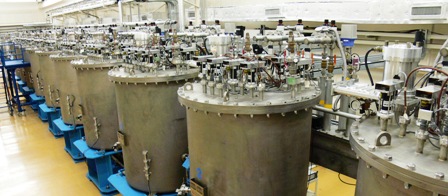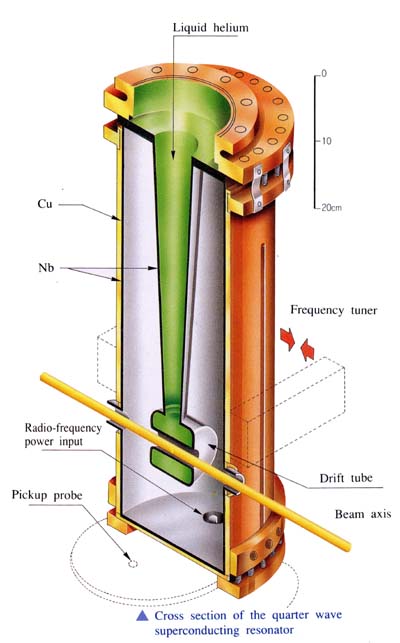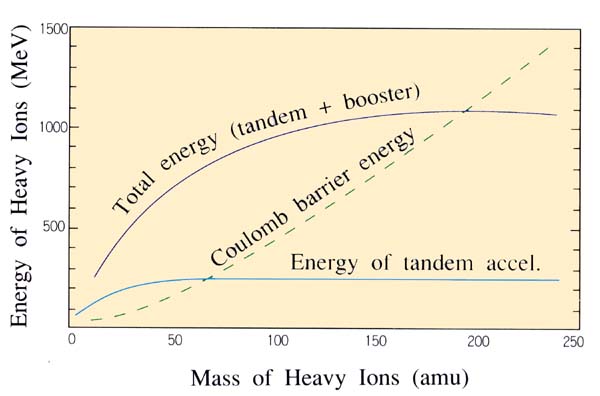

High energy heavy ions, which can cause nuclear reactions with any heavy elements, are desired for fundamental studies in nuclear physics, nuclear chemistry, solid state physics and so on.
For this purpose, the superconducting booster using radio-frequency superconductivity was built to increase energy of heavy ions from the tandem accelerator enough to cause nuclear reactions between any combination of projectile ions and target elements up to a mass number of about 200 amu.

|
| Structure and acceleration method |
|
The superconducting booster is installed on a linear extension of the straight beam line from the tandem accelerator, and the beams accelerated again by the booster are led to the target room after deflection of 90 degrees by the analyzing magnet.
Superconducting bunchers apply velocity modulation to the ion beams from the tandem accelerator. By the bunchers, the ion beams are compressed into a pulsed form of 130 MHz at the entrance of the linac, and then, injected into the linac. The superconducting linac has ten cryostats, each of which has four superconducting resonators. Every resonator is connected to a radio-frequency control circuit, and the amplitude and phase of the radio-frequency electric field can be controlled independently from others. Heavy ion beams are boosted, when every resonator phase is adjusted to synchronize with the movement of the ion beams when the beams pass the resonators. The superconducting debuncher having two superconducting resonators makes the energy of the beams uniform. The pulsed beams accelerated by the superconducting linac have a spread of energy in their head and tail parts. The energy spread can be canceled, by the radio-frequency electric field in the debuncher resonator after the beams run 10 m. The booster is equipped with two liquid helium refrigerators, for cooling the superconducting resonators to about 4.5 K. |
| Superconducting resonator |
|
A superconducting resonator, which is a resonant cavity made of a superconductor, can store the energy of resonant radio frequency and produce a strong radio-frequency electric field.
The superconducting resonator takes advantage of very small loss of electric power for acceleration of the heavy ions to obtain a strong and continuous radio-frequency electric field since the radio-frequency currents flowing on the wall of the cavity is about one part of 100,000 compared with the loss of the cavity made of normal conductors.
This advantage is applied to the resonators for acceleration of heavy ions. |
|
|
The cross section of a quarter-wave-line superconducting resonator, which was developed at this laboratory in JAERI, is shown in the figure to the right. The cavity made of Nb material can generate an electric field above 6MV/m around the drift tube with a radio-frequency power loss only 4 watts at 4.2 K. Heavy ions are accelerated in the front and rear gaps of the drift tube. The electric fields at the both sides of the drift tube turn reversely at 130 MHz. Heavy ions are accelerated in the front gap when the electric field is in the beam direction. After a turn of the electric field and passage of the ions in the drift tube, the ions along the beam direction in the rear gap are given energy again by the field. The acceleration by the resonator is possible if the ion beam velocity is above 5% of the light velocity, and optimum acceleration efficiency is given at 10% of the light velocity. Maximum acceleration energy per electric charge is 600-800 keV per resonator. |

|
| Energy performance |
| The acceleration energy gained by the superconducting booster is shown in the figure to the right. Nuclear reactions will occur at energy higher than the Coulomb barrier energy denoted by the broken line. This figure indicates that the reinforcement of energy by the superconducting booster yielded a tremendous increase in number of useful bombarding nuclei for experiments of nuclear physics ji-e,heavy ions useful for nuclear reactions, which had been limited up to medium heavy ions like copper ones, were extended to the mass number of about 200 amu by the addition of the superconducting booster. That is ,unclear reactions can happen even for collision between accelerated gold ions and target gold nuclei. |

|
| Brief history of the development |
|
In 1985, a prototype resonator was made using pure niobium and composite plates of niobium and copper. A high acceleration field of 5MV/m was examined for the resonator, and then, the resonator design was adopted into the present booster resonators. In 1986, a superconducting buncher was manufactured. The acceleration field of the superconducting resonator exceeded 6MV/m, and experiment of bunching heavy ions was performed. In 1988, the production acceleration units started and the whole system of the superconducting booster was completed in 1993. In 1995, a recoil-type mass separator was installed, which is being used for separating unstable nuclei produced during nucleus-nucleus collisions. It opened the way for carrying out an experimental study of exotic nuclei. |
